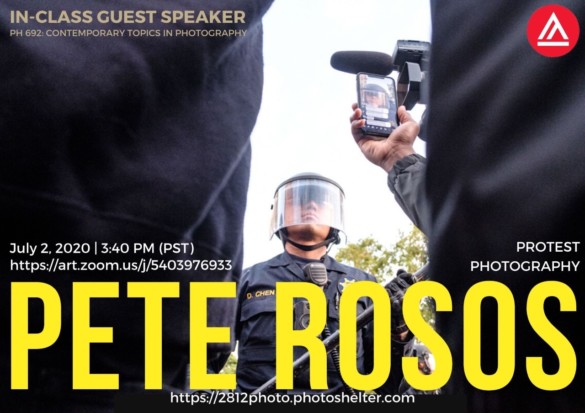By Greta Chiocchetti
Although classes may be online through the rest of 2020, students are still enjoying one of the greatest benefits of an Academy education: meeting and learning from established working professionals in their field. For students in School of Photography Associate Director Timothy Archibald’s Contemporary Topics in Photography class, this means having the opportunity for an intimate conversation with a well-known photographer on a weekly basis.
On Thursday, July 2, students tuned in from around the country for a Q&A session with Pete Rosos, a Bay Area-based photographer. Rosos, a freelancer who has worked with fashion brands, nonprofits, and publications, is known for his street photography coverage of the Bay Area, including the recent Black Lives Matter protests in Oakland and San Francisco. Over the course of the class, he shared valuable insight and advice for students interested in cataloging this decisive moment in history.
“It never really hit me as to why folks were protesting—it wasn’t until the Black Lives Matter protests back in 2014, where all of a sudden, I had guys dressed up like stormtroopers spraying tear gas all over my front lawn,” said Rosos. “And it changed my perspective, an awful lot, in terms of what the protest was, what people were demanding [to] be changed, and why you should go to a protest, why they needed to be documented.”
As they followed along on Zoom, students submitted their questions for Rosos through the live chat function. Naturally, one of the first questions to come up was what he thought the absolute “don’ts” of covering a protest were.
“Do not try to claim constitutional high ground in a situation when you’re surrounded by a bunch of people who are quite literally telling you that if you don’t stop taking pictures, they’re going to smash your camera to pieces,” said Rosos, “because eventually your camera will get smashed to pieces. That’s something that I discovered. The way I look at it is—in that particular moment—I’m going to think more practically than I am ideologically and I’ll wait. Because it’s just a matter of time before another moment is going to come up that I will get the chance to shoot.”
Rosos also encouraged students to avoid going for the low-hanging fruit by simply taking photos of the protestors’ signs.
“It is extraordinarily easy to go to a protest and photograph people with signs, but that’s not really telling you why they’re there,” said Rosos. “You know, why ‘f–k the police’? Who are these people? What’s happening here? You know, try and find interesting subject matter where all of a sudden you’re starting to see what the opposing views are.”
After working in the industry for almost two decades, Rosos said he felt a responsibility to give back to the next generation of photographers and enjoyed having the opportunity to speak to Academy students.
“If you have any sense of what it is to be a human being, if you have any experience in your life, you should be able to impart that experience to others who have similar interests as you,” said Rosos. “Without question. And if you actually know what you’re talking about, or you have the results to back up the fact that you know what you’re talking about, then yes, you should also impart that knowledge on those who are curious.”
As a working photographer, Archibald said he has been able to build a wide circle of professional connections, including Rosos, whose work he long admired.
“It’s definitely something that is unique to the Academy’s approach, that if you’re a working photographer, for example, you have all these people that you’re aware of, you’re networking with, and you’re bumping into, and you have a very vibrant collection of connections,” said Archibald. “I’ve cultivated a big network of people whose work I love, and I know it will be a huge benefit to the students as they try to break into the industry.”
